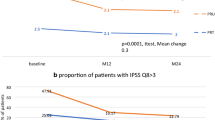Abstract
Purpose
To identify patient characteristics associated with general practitioner’s (GP) initial treatment decision in men with lower urinary tract symptoms (LUTS) and to test the hypothesis that a different coping style of patients results in different GP behaviour regarding treatment.
Materials and methods
A longitudinal, population-based study with a follow-up period of 6.5 years was conducted among 1688 men aged 50–78 years old. Data were collected on quality of life, symptom severity based on the International prostate symptom score (IPSS) and coping. Information on primary care seeking and GP’s initial management during 2 years of follow-up of all participants was collected from the general practitioners record.
Results
Data were obtained of 68 men, without a history of LUTS, who had a first GP visit for LUTS during the study period. In 54.4% of the cases the GP prescribed medication, independent of symptom severity. In the group of men with a bad disease-specific QOL those with a high passive-reaction-pattern were treated less frequently than those with a low passive-reaction-pattern.
Conclusion
Findings from this quantitative study are consistent with the hypothesis that different coping styles of patients may result in different GP behaviour regarding treatment. The use of the coping style passive-reaction-pattern has a large influence on GP’s initial management in men with LUTS.
Similar content being viewed by others
References
Nutting PA, Franks P, Clancy CM (1992) Referral and consultation in primary care: Do we understand what we’re doing? J Fam Pract 35:21–23
Newton J, Hayes V, Hutchinson A (1991) Factors influencing general practitioners’ referral decisions. Fam Pract 8:308–313
Franks P, Williams GC, Zwanziger J, Mooney C, Sorbero M (2000) Why do physicians vary so widely in their referral rates? J Gen Intern Med 15:163–168
Fleming DM (1989) Consultation rates in English general practice. J R Coll Gen Pract 39:68–72
Carr-Hill RA, Rice N, Roland M (1996) Socioeconomic determinants of rates of consultation in general practice based on fourth national morbidity survey of general practices. Br Med J 312:1008–1012
Carlisle R, Johnstone S (1998) The relationship between census-derived socio-economic variables and general practice consultation rates in three town centre practices. Br J Gen Pract 48:1675–1678
Fylkesnes K (1993) Determinants of health care utilization – visits and referrals. Scand J Soc Med 21:40–50
Shea D, Stuart B, Vasey J, Nag S (1999) Medicare physician referral patterns. Health Serv Res 34:331–348
de la Rosette JJ, Alivizatos G, Madersbacher S, Perachino M, Thomas D, Desgrandchamps F, de Wildt M. EAU Guidelines on benign prostatic hyperplasia (BPH). Eur Urol 2001; 40: 256–263; discussion 264
Coulter A, Elwyn G (2002) What do patients want from high-quality general practice and how do we involve them in improvement? Br J Gen Pract 52(Suppl):S22–S26
Blanker MH, Groeneveld FP, Prins A, Bernsen RM, Bohnen AM, Bosch JL (2000) Strong effects of definition and nonresponse bias on prevalence rates of clinical benign prostatic hyperplasia: The Krimpen study of male urogenital tract problems and general health status. BJU Int 85:665–671
Barry MJ, Fowler FJ, O’Leary MP, Bruskewitz RC, Holtgrewe HL, Mebust WK, Cockett ATK, Association TmcotAU (1992) The American Urological Association Symptom Index for benign prostatic hyperplasia. J Urol 148:1549–1557
Joosten J and Drop MJ (1987) [The reliability and comparability of the three versions of the ISH] De betrouwbaarheid en vergelijkbaarheid van de drie versies van de VOEG. Gezondheid Samenleving 8:251–265
Jacobs HM, Luttik A, Touw-Otten FW, de Melker RA (1990) [The sickness impact profile; results of an evaluation study of the Dutch version] De ‘sickness impact profile’; resultaten van een valideringsonderzoek van de Nederlandse versie. Ned Tijdschr Geneeskd 134:1950–1954
Boyle P, Robertson C, Mazzetta C, Keech M, Hobbs R, Fourcade R, Kiemeney L, Lee C (2003) The relationship between lower urinary tract symptoms and health status: The UREPIK study. BJU Int 92:575–580
Schreurs PJG, Willige GVd, Brosschot JF, Tellegen B and Graus GMH. [Utrecht Copinglist: UCL] De Utrechtse Copinglijst: UCL. Lisse, Swetz & Zeitlinger, 1993: 1–40
Verhamme KM, Dieleman JP, Bleumink GS, Bosch JL, Stricker BH, Sturkenboom MC (2003) Treatment strategies, patterns of drug use and treatment discontinuation in men with LUTS suggestive of benign prostatic hyperplasia: The Triumph project. Eur Urol 44:539–545
Wolters R, Wensing M, Klomp M, van Weel C, Grol R (2004) Shared care and the management of lower urinary tract symptoms. BJU Int 94:1287–1290
Hees S. Benign Prostatic Hyperplasia; Practice variation and appropriate care (In Dutch: praktijkvariatie en gepaste zorg. Een onderzoek onder huisartsen in Zuidelijk Zuid-Holland, Westelijk Noord-Brabant en Zeeland). Rotterdam, Erasmus MC, 1998: 52 pp
Klomp ML, Rosmalen CF, Romeijnders AC, Oosterhof GO, Schlatmann TJ (1998) [Benign prostatic hyperplasia; recommendations for transmural care. Working Group, Dutch College of General Practitioners and Netherlands College of Urologists] Benigne prostaathyperplasie; aanbevelingen voor transmurale zorg. Ned Tijdschr Geneeskd 142: 2563–2568
Author information
Authors and Affiliations
Corresponding author
Rights and permissions
About this article
Cite this article
Kok, E.T., Bohnen, A.M., Bosch, J.L.H.R. et al. Patient’s Quality of Life and Coping Style Influence General Practitioner’s Management in Men with Lower Urinary Tract Symptoms: The Krimpen Study. Qual Life Res 15, 1335–1343 (2006). https://doi.org/10.1007/s11136-006-0013-0
Accepted:
Published:
Issue Date:
DOI: https://doi.org/10.1007/s11136-006-0013-0




